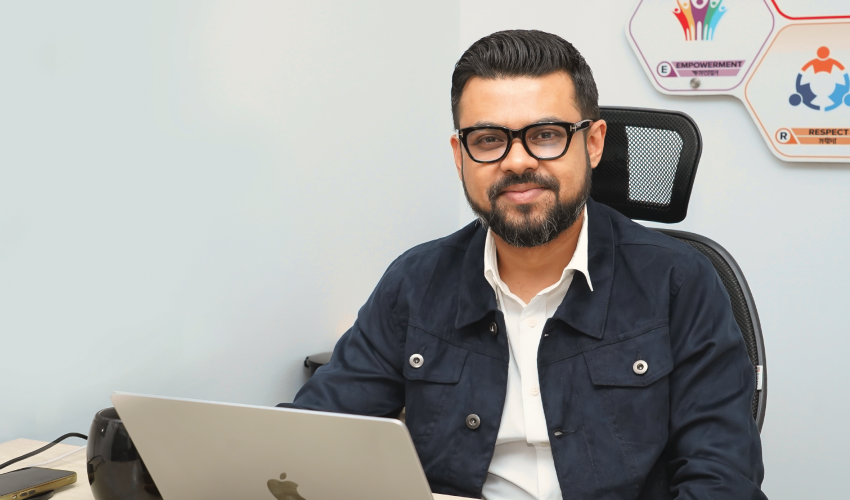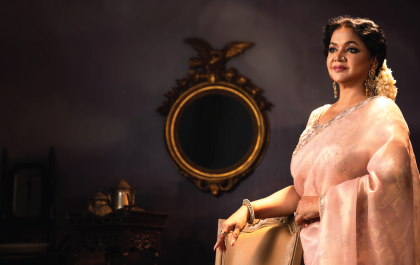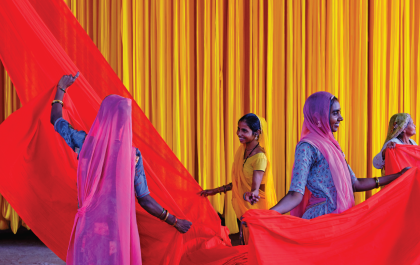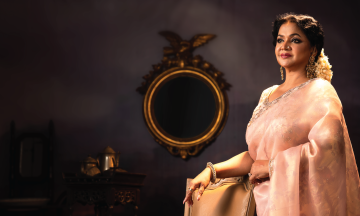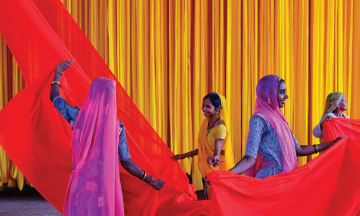Salman A Khan on leadership, sustainability and the future of footwear
By Ayman Anika
Salman A Khan, the dynamic Head of Product at Apex Footwear Limited, exemplifies what it means to lead with vision and purpose in the fast-paced world of retail. Beginning his professional journey as a Management Trainee, Khan has climbed the corporate ladder with grit, adaptability, and an unwavering commitment to excellence. With over a decade of experience across diverse industries and roles, he has honed a leadership style that balances innovation, data-driven decision-making, and empowerment.
Beyond his professional achievements, Khan embraces a minimalist lifestyle that fuels his creativity and keeps him grounded. With MWB, the charismatic leader shares his remarkable journey, life philosophy, and aspirations for shaping the future of retail in Bangladesh and beyond.
You began your career as a Management Trainee. Transitioning from a trainee to the Head of Product is a notable achievement. What challenges did you face during this progression?
When I started as a Management Trainee, I quickly realized that product management is the backbone of the retail industry. It’s not just about managing products; it’s about laying the foundation for the entire business. The challenges were immense – starting from understanding the product lifecycle, ensuring effective inventory management, and aligning the profitability and margins of each product. For a product manager, success is heavily measured in numbers and KPIs. This constant pressure to deliver results was both daunting and motivating.
One of the biggest challenges I faced was handling inventory. In retail, holding excessive inventory can lead to financial losses, while insufficient stock can hurt sales. Balancing this was a continuous struggle. Another significant hurdle was ensuring the profitability of every product after accounting for all expenses. Product management requires careful observation, data-driven decision-making, and strategic planning. From the launch of a product to its performance in the market, every detail mattered. The process taught me to stay observant, learn from market trends, and take failures constructively.
Another major challenge was dealing with criticism. As the Head of Product, I oversee the development of thousands of products, which often invites scrutiny and feedback from multiple directions – colleagues, clients, and even the market. Criticism is an integral part of the role, and learning to take it positively while maintaining focus on improvements has been essential. Whether it was launching innovative electronics in my previous roles or managing footwear categories in my current one, addressing concerns and delivering value consistently required adaptability and resilience.
Moreover, moving up the ladder meant proving myself at every stage. From being a Management Trainee, I transitioned to roles like Senior Brand Officer, Retail Operations Manager, and Deputy Manager in different organizations, each with its unique challenges. For instance, at Samsung, I managed home appliances and visual displays, successfully turning the business around. At Apex, I worked my way up from Assistant Manager to Deputy General Manager and eventually to the Head of Product. This progression required immense effort, as I made it a point to touch every position and to thoroughly understand every aspect of the business.
Throughout this journey, the key challenges included learning new industries, building cross-functional expertise, and delivering results in a number-driven environment. Each role demanded hard work, adaptability, and a clear understanding of business fundamentals. Despite the challenges, this journey has been rewarding, as it has shaped me into the professional I am today.
As a leader with over a decade of experience, what do you think has been the most noteworthy evolution in your leadership style?
The evolution of my leadership style has been a dynamic journey shaped by experience, challenges, and growth. Over the years, I’ve learned that effective leadership is not just about delegating tasks but about striking a balance between delegation and monitoring, while also trusting the team to grow and deliver.
In my earlier years as a leader, I took a hands-on, micromanagement approach. Coming from a multinational organization, I was accustomed to a fast-paced, structured, and target-oriented environment. However, when I transitioned to a domestic organization, I quickly realized the team’s exposure and speed were not aligned with mine.
This difference required a more meticulous approach. I had to monitor every detail, line by line, ensuring every parameter was met and every goal achieved. At the same time, I knew that delegating without proper monitoring wouldn’t yield results, so I maintained a close but supportive oversight to guide the team effectively.
Over time, I realized that leadership isn’t just about controlling outcomes but also about empowering people. While initial micromanagement was necessary to build a strong foundation, I understood that as responsibilities grew, direct involvement in every aspect wasn’t feasible. Instead, I learned to trust my team members, letting them take ownership of their roles. This doesn’t mean stepping away completely – it’s about providing the right guidance and allowing them to learn from their decisions, even if it means letting them fail occasionally to understand and grow.
What has truly shaped my leadership evolution is the ability to identify and maintain certain standards. I’ve been fortunate to work with teams that shared my commitment to delivering results. Over time, I’ve built trust with my teams by setting clear expectations, maintaining transparency, and fostering an environment where people feel empowered to perform. This trust and alignment have been crucial, as they allow me to step back when needed and focus on broader strategic goals without compromising the quality of work.
Looking back, I’d say the most noteworthy shift in my leadership style has been moving from a hands-on, detail-oriented approach to one that is more balanced – still keeping a pulse on critical elements while trusting my team to deliver. It’s about enabling others to succeed while ensuring the organization meets its goals. This evolution has made me a more adaptive and empathetic leader, capable of managing diverse teams and navigating complex challenges effectively.
How do you inspire your team to think beyond traditional product designs and embrace innovation?
Inspiring a team to think beyond traditional product designs and embrace innovation requires a multifaceted approach rooted in both passion and process. As a product manager, I view innovation as a core responsibility, not just a byproduct of the job. For me, it’s all about solving consumer pain points and addressing unmet needs. This mindset is at the heart of how I lead my team.
Firstly, I encourage my team to think out of the box by integrating structured methodologies with creative freedom. Product innovation is not a sporadic effort but a continuous process that involves seasonal portfolio refreshes every six months. To achieve this, we combine market insights, consumer feedback, and internal brainstorming sessions.
For instance, we rigorously visit various types of stores – premium, merchant, and performance-focused – to understand different consumer profiles and their preferences. This direct interaction with the market helps us develop a deep understanding of evolving trends and unmet demands.
Additionally, we draw inspiration from both local and global markets. My team frequently travels to places like Dubai, Malaysia, and Thailand, and even to India whenever it is open, to explore trends and ideas for specific collections. These visits allow us to absorb the essence of international designs and adapt them for our domestic audience. Alongside these travels, we also rely on online platforms to keep track of what leading global brands are doing. This combination of physical exploration and digital research enables us to bring fresh perspectives into our designs. Another critical aspect of my leadership style is leveraging data-driven decision-making. Historical business data plays a significant role in identifying trends, such as the shift in Bangladeshi women’s preferences from flats to mid-heel shoes. By analyzing these trends, we back up our market observations with concrete numbers. This blend of intuition and analytics ensures that our innovations are both inspired and practical, ready to meet market demands effectively.
To foster a culture of enthusiasm and ownership, I emphasize living by the brand and the products. I personally immerse myself in the products we create, from ideation to launch. For instance, when we recently launched boots for women, I shared my excitement both within and outside the team. This passion resonates with the team, creating an environment where they feel motivated to take pride in their work.
I also believe in the power of celebrating successes and sharing feedback. Any appreciation I receive for our products, whether from within the organization or outside, is shared with the team to lift their spirits and reinforce their commitment. Beyond work, I ensure we have opportunities to bond, such as our Thursday night gatherings. This balance of hard work and camaraderie builds a cohesive, motivated team.
Ultimately, I lead by example. By showing my own passion for our products, engaging actively in the design and decision-making processes, and demonstrating how innovation aligns with business success, I inspire my team to think creatively and push boundaries. It’s this collective effort and enthusiasm that drives us to consistently deliver innovative products to the market.
Can you walk us through your process of planning a launch strategy, from the initial concept to retail shelves?
The process begins with gathering inspiration. This could come from pictorial references, market visits, or even sample purchases. However, when we buy samples, it’s not to copy them but to learn from their design, materials, and overall appeal. We adhere to our standards, ensuring that our materials, designs, and testing processes are superior. Inspiration hunting is not just about aesthetics but solving consumer problems and addressing gaps in the market.
We have an advanced design lab equipped for research and development. Each product category has dedicated product managers and designers, often trained in footwear technology, who understand the science of shoemaking. Shoemaking is a complex process involving precise measurements, material selection, and ergonomic considerations. Every shoe we create is designed to meet these scientific standards, ensuring not only visual appeal but also functionality and durability.
Once the initial concept is ready, the design team develops the
first prototype. This prototype undergoes an internal review involving the product team and the R&D team. The prototype is assessed for alignment with brand philosophy, pricing strategies, and other critical parameters.
Creating a prototype is a challenging process, especially given the weak vertical integration in the Bangladeshi footwear industry. Components like soles often need to be sourced externally, adding to the complexity. Once a prototype is ready, it is rigorously tested, and if any issues arise, the entire process may need to be repeated. This involves significant mental and physical effort, as team members often travel between factories and the design lab to ensure precision.
After the prototypes are finalized, a range presentation is prepared. This is a comprehensive presentation where the prototypes are displayed alongside numerical data and business insights. The data includes historical sales performance, market trends, and projections for the new collection. This step is critical to justify why each product deserves a place in the collection. The range presentation involves input from multiple departments, including product managers, designers, the Managing Director, and other relevant stakeholders. Every product is scrutinized, feedback is collected, and necessary corrections are made. Although it’s impossible to accommodate all suggestions, we prioritize changes that align with our goals and consumer expectations. Once the final adjustments are made, the collection is approved for launch. This includes setting price points, defining target consumer segments, and planning marketing strategies. Each product undergoes rigorous quality checks to ensure it meets the highest standards before being moved to production.
The launch strategy is executed across all retail channels, ensuring that the products are well-positioned in the market. Every aspect, from shelf placement to promotional activities, is meticulously planned. Feedback from early sales is closely monitored to make necessary adjustments and optimize future launches. After the products hit the shelves, we track their performance in real time. We analyze consumer feedback, sales data, and market trends to measure the launch’s success. This continuous monitoring helps us refine our strategies for future collections.
The entire process, while rewarding, is incredibly challenging. From sourcing materials in a market with weak backward linkages to managing critical feedback during range presentations, every step demands attention to detail and a commitment to excellence. Product management, in this context, can feel like a thankless job, but the satisfaction of seeing a successful launch makes it worthwhile.
In essence, our launch strategy is a blend of creativity, science, and meticulous planning. By staying true to our standards and engaging in continuous improvement, we ensure that each product not only meets but exceeds consumer expectations.
Given the global emphasis on sustainability, how is Apex Footwear addressing environmental concerns? Could Apex potentially explore biodegradable or fully recyclable shoe lines? What about the leather and footwear production processes?
At Apex Footwear, sustainability isn’t just a buzzword – it’s deeply embedded in how we operate and what we stand for. We’re proud to be the only company in Bangladesh’s footwear industry that publishes a Sustainability Report, even though there’s no legal obligation to do so. It’s a reflection of our commitment to transparency and environmental stewardship. In fact, we hold some of the most prestigious certifications in sustainability, such as LEED certification, which I like to call the “Oscars and Grammys of sustainability.” These achievements underline our efforts to set a benchmark in eco-conscious practices.
One area we’ve focused on is resource efficiency. For instance, we have our own rainwater harvesting systems, solar energy setups, and an Effluent Treatment Plant (ETP) to ensure the water we discharge meets stringent environmental standards. These initiatives aren’t about cutting corners or meeting minimum requirements – they’re about doing what’s right for the planet, even if our consumers don’t always see or demand it.
Another exciting project we’ve worked on is the “From Plastic to Product” campaign, where we recycle plastic bottles into materials for our footwear. This was a bold move. Yet, they proved that recycled materials could deliver both quality and style. Similarly, we’ve been innovative with leather waste, repurposing it into small goods like keyrings, belts, coin holders etc. It’s a creative way to minimize waste while adding value to our portfolio.
Sustainability does come with its challenges, though. In Bangladesh, many consumers aren’t yet ready to pay a premium for eco-friendly products. There’s also this perception that recycled or sustainable items might lack quality. But we’ve worked hard to change that narrative. For instance, in our women’s footwear line, we use high-quality synthetic uppers, which some might dismiss as “not genuine leather,” but globally, these materials are recognized for their durability and sustainability.
For us, sustainability isn’t just about ticking boxes or marketing – it’s in our DNA. Even if consumers don’t fully understand the value yet, we continue to invest in these practices because we believe in them. We’re building for the future, ensuring that every product we make aligns with our values and creates a better, more sustainable world. That’s what Apex stands for, and it’s something we’re incredibly proud of.
As someone leading in a high-pressure industry, how do you unwind and find inspiration outside of work?
I find peace and inspiration by embracing a minimalistic lifestyle. I’m a very private person, preferring a simple and intentional way of living that allows me to focus on what truly matters. For the last eight years, I’ve consciously stayed away from social media platforms like Facebook, maintaining only a LinkedIn and Instagram profile for professional purposes. This helps me keep my private and professional lives separate, and I cherish the time I spend at home with my family.
When it comes to indulgences, my passions are perfumes and music. Perfumes are where most of my money goes – I have a collection that I deeply adore. Music is another escape for me; I love playing LP records and have my own set of vintage records that I turn to when I need to relax. These small joys bring me immense satisfaction and help me unwind.
Apart from that, I enjoy exploring evolving lifestyle movements that resonate with my values. Minimalism is something I’ve been particularly drawn to over the past few years. I’ve explored this philosophy extensively, watching documentaries like The Minimalists on Netflix and following pioneers like Matt D’Avella on YouTube, who have made significant contributions to the movement. Minimalism has taught me to focus on the essentials and let go of unnecessary clutter – both physically and mentally. It’s a practice I’ve adopted in my personal life, and it has brought me clarity and peace.
Another concept that intrigues me is the FIRE movement (Financial Independence, Retire Early). This movement emphasizes living frugally and saving aggressively to achieve financial independence and retire early. It’s fascinating to learn how couples in the US live intentionally on modest budgets while working towards their financial goals. While I’m not actively pursuing FIRE, I find the philosophy inspiring and align with its principles of intentional living.
I’ve realized that true fulfillment doesn’t come from material possessions but from meaningful experiences and connections. Practicing frugality and focusing on essentials helps me stay grounded, even in the fast-paced world of marketing and product management.
In essence, my personal life is about simplicity, intentionality, and nurturing the things that bring me joy. This approach not only helps me recharge but also keeps me inspired to navigate the demands of my professional life.




